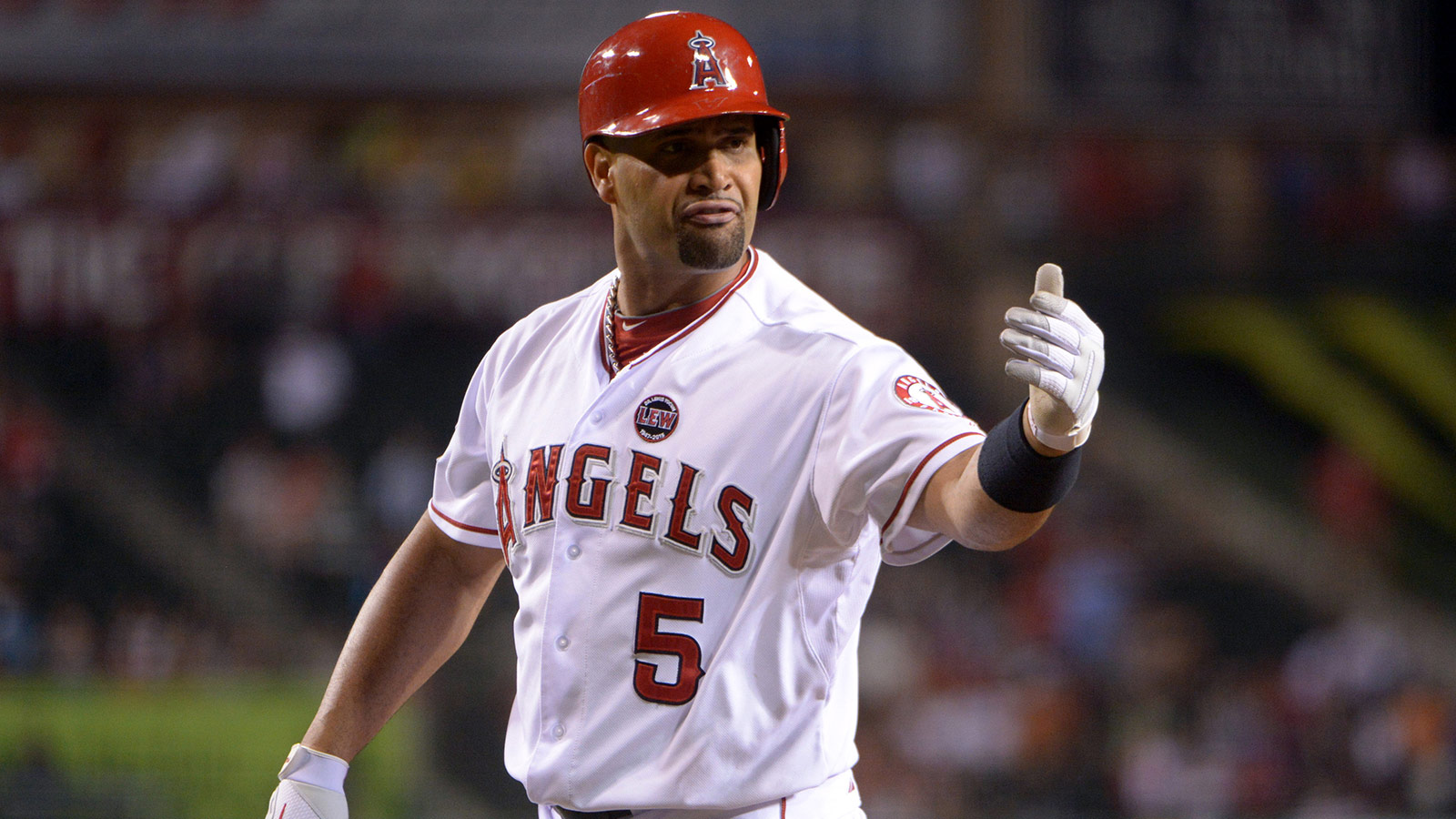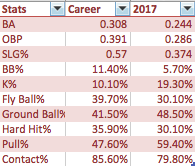Albert Pujols is 5 home runs away from reaching the prestigious 600 home run mark, a number only 8 other players in MLB history have reached. His 3,000th hit is in sight to be reached possibly next season. It should be a time for celebration for Albert Pujols and the illustrious Hall of Fame numbers he’s accumulated. Yet, there is still a huge feeling of dissatisfaction among the Angels fan base and, presumably, the Angels organization. The feeling of wanting just a bit more from “The Machine” has been in existence since the very first month Albert Pujols played in an Angels uniform and it’s still present today.
On December 8th, 2011, the Angels shocked the baseball world when they signed Albert Pujols to a 10 year 240 million dollar deal. At the time, Pujols was arguably one of the most valuable players in all of baseball and was on a surefire Hall of Fame path. The Angels knew the deal would likely not end very well on the backend years but the rationale behind it was to get a ton of production up front, plus a World Series title or 2, and deal with not so great production on the back end. As you may know by now, the Angels received neither great production up front nor any World Series titles.
The first 5 years of the Pujols deal paid him 100 million dollars. On the open market, free agents are generally paid 8 million dollar per 1 Win Above Replacement(WAR). If you include inflation that has occurred since 2011, Pujols should’ve roughly been paid 7-8 million dollars per 1 WAR. Pujols, through his 1st 5 years as an Angel, racked up 9.8 WAR, which comes out to a rough estimate of 68.6-78.4 million dollars that he should have earned. In the years that were supposed to be the most productive years of the deal, Pujols fell short, by a wide margin, mainly due to declining plate discipline, athletic ability and constant injuries. If the original deal had been a 5/100 deal, the bad press that Pujols has received likely wouldn’t have occurred. The issue is he is owed a whopping 140 million dollars for the next 5 seasons, which doesn’t include incentives Pujols may make, including 3 million dollars for his 3,000th hit. Entering the 6th year of the deal, expectations were moderate for Pujols, with the simply hope that he could avoid declining even more.
The signs so far in 2017 are not pretty, as the 37 year old is really struggling out of the gate. After undergoing another offseason surgery on his foot, Pujols came into Spring Training a tad rusty, just like in 2016 and the seasons before, and he has started slow as a result. While the previous seasons saw a slow start due to a little bit of bad luck, this year doesn’t just look like bad luck. Through 138 plate appearances, the numbers are down across the board in every possible way. Here are his career numbers lined up next to his 2017 numbers, all of which would represent career worst marks.
Pujols is striking out more than ever while walking less. He’s pulling the ball more than ever but not in the way you’d want him to: he’s hitting a bunch of ground balls into the shift. He’s making less hard contact, hitting the ball on the ground more than ever and he’s hitting more infield fly balls. A look into his Statcast numbers line up exactly with his statistics he has posted so far. Albert Pujols has a 87.3 mph average exit velocity this year, compared to 92.5 mph in 2016 . He has only barreled up 4.9% of his batted balls in 2017(balls expected to have .500+ batting average and 1.500+ slugging percentage) compared to his 9.5% mark in 2016.
Sure, he’s driving in runs, as evidenced by his 24 RBIs, which rank 19th in baseball, but it’s a byproduct of hitting behind the best player in baseball. Many fans and writers have claimed that Pujols is a “clutch hitter”, which is an argument that just isn’t factually correct and is an argument that has had plenty of research done on it. Many hitters hit better with runners in scoring position due to the fact that plenty of pitchers struggle to pitch out of the stretch compared to the windup so Pujols isn’t some special case. Pujols has been better with runners in scoring position(208 wRC+) compared to no runners on(16 wRC+) this year in a small sample. He was also better with runners on base last season. However, he was worse with runners on by a wide margin in 2015 and 2014. He was better with runners on in an injury shortened 2013 year and was just about equal in 2012, his 1st year with the Angels. Since he became an Angel, Pujols has a 112 wRC+ with no runners on compared to a 121 wRC+ with runners in scoring position. That’s a bit better but again, most hitters do a bit better with runners on. Pujols has driven in runs because Mike Trout is consistently on base in front of him.
There’s also a theory floating around that Albert Pujols changes his approach with runners on base, essentially trying to put the ball in play, drive the ball away from the shift and just drive guys in. Pujols does have a significantly higher BB/K ratio with runners on(1.36) compared to the bases empty(0.42). Part of that is due to teams deciding to not pitch to Pujols and just loading the bases to face whoever is hitting behind him. Pujols does deserve some credit for that but those 52 intentional walks he’s received since 2012 have bloated his walk rate without him changing too much, which isn’t helping support the changed approach theory. Nothing changes with the way Pujols tries to hit the ball, however. With the bases empty since 2012, Pujols has a 43.2% ground ball rate, 38.6% fly ball rate, 49.4% pull rate and 17.4% opposite field rate. With runners on, Pujols has a 44.7% ground ball rate, 37.3% fly ball rate, 49.4% pull rate and 17.7% opposite field rate. So there is something to the idea that Pujols is better at putting the ball in play and has a more selective eye with runners on but he’s doing nothing differently with the way he’s hitting the baseball and the overall results don’t really portray a better Albert Pujols with runners on.
Albert Pujols may be a shell of his former self but he does deserve credit for a number of achievements. Since he became an Angel, Pujols has posted a 118 wRC+ and 9.7 WAR, hardly disastrous numbers, just numbers that fall well short of the expectations you receive from signing a mega contract. Pujols has played through a number of injuries throughout this process, which is better than the Angels simply paying him to be on and off the disabled list and provide nothing for the team. He’s also still one of the most respected players in baseball, providing a clubhouse presence for many Angels players and has apparently been a huge help for Mike Trout since he arrived in his rookie year, which was coincidentally in 2012. The reality is Albert Pujols has performed at a level that would earn him half of the contract he signed but he hasn’t been a complete zero with the Angels.
Unfortunately, Albert Pujols will be getting a raise each year until his contract ends in the year 2021. Barring Pujols retiring before the contract is up, something that probably shouldn’t be counted on, there are some potentially ugly years coming up in this deal. At 37 years old, Father Time is starting to really creep in and sap Albert Pujols of any baseball skills he might have remaining. The hope for the Angels is that Pujols is just starting slow and he can still be a 110-115 wRC+ bat just for a few more years but the early signs point to a potentially league average or worse bat going forward. It has been a remarkable career for Albert Pujols but the days of the elite level MVP performer, even above average player, may be gone.
Add The Sports Daily to your Google News Feed!

